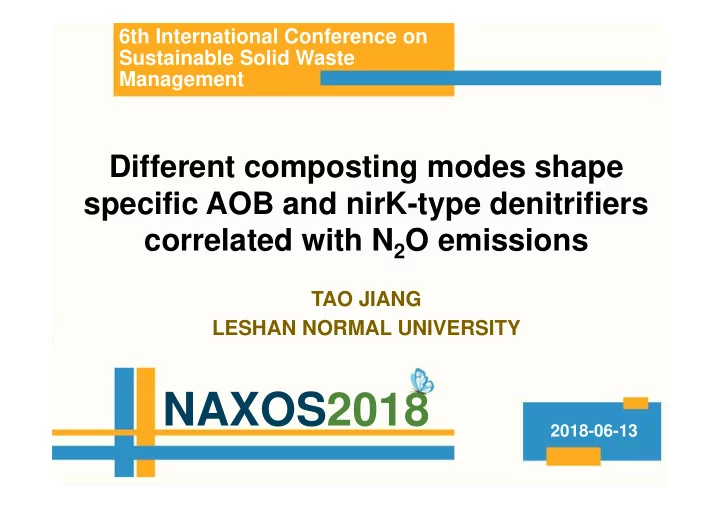

6th International Conference on Sustainable Solid Waste Management Different composting modes shape specific AOB and nirK-type denitrifiers correlated with N 2 O emissions TAO JIANG LESHAN NORMAL UNIVERSITY NAXOS2018 2018-06-13
Project partner Guoxue Li Tao Jiang Jiali Chang China Leshan Leshan Agricultural Normal Normal University University University
Background N 2 O in the air • N 2 O is an important greenhouse gas. • N 2 O content in the air increased 20% in the last 50 years • N 2 O is considered to be an important factor in ozone depletion. GWP data was changed in IPCC Climate Change 2014-Synthesis Report GWP GTP Lifetime(yr) Cumulative Cumulative Temperature Temperature forcing over forcing over change after change after 20 yr 100 yr 20 yr 100 yr CO 2 1 1 1 1 CH 4 12.4 84 28 67 4 N 2 O 121 264 265 277 234 CF 4 50,000 4880 6630 5270 8040 (IPCC, 2014; Ravishankara et al., 2009; Mosier et al.,1998; Houghton et al., 2001)
Background N 2 O emission in agriculture • More than 80% N 2 O emitted from agriculture, including manure management, synthetic fertilizer and manure application / deposition. • Composting is one of the significant sources of N 2 O production, which accounts for approximately 30-50% of the annual global N 2 O emissions from agriculture • When the compost was normally operated, N 2 O emission account for 0.2-3.0% of total nitrogen that was about 26-61 kg CO 2 eq/t manure. (IPCC, 2014; USEPA , 2011 ; FAOSTAT , 2013 )
Background N 2 O production by microorganisms Ammonia oxidizer Nitrite oxidizer (bacteria or archaea) nxr amoA hao hao + - NH 4 NH 4 OH [NOH] NO 2 - NO 3 narG napA euk-nr nirK N 2 O 2 H 2 nosZ / ( nirK + nirS ) nirS Denitrifiers N 2 N 2 O NO nosZ norB (Canfield, 2010; Madae et al., 2011; Angnes et al., 2013; Li et al., 2017; Bian et al., 2017)
Scientific problem What about the microbial community structure relationship with N 2 O emissions during composting.
Materials and methods Raw materials • Cornstalk air dried and chopped to ~ 5 -10 cm; • Pig faeces from Ganqingfen system of a local pig farm. Samples TOC TN Ammonium Moisture C/N (g·kg -1 ) (g·kg -1 ) (g·kg -1 ) content (%) Pig faeces 343.7 26.5 7.4 71.8 13.0 Cornstalk 419.0 9.9 — 9.3 42.3 Mixture 367.4 21.2 5.7 63.6 17.3
Materials and methods Composting methods • Materials were composted in 1.2 m 3 bins for 10 week. • Total 3 treatments: 1 5 Static, Turn, Forced aeration. 2 • Turning frequency is 1/week. 4 • Aeration rate is 0.25 L·kgDM -1 ·min -1 . 3 1. Wooden boards with sampling holes; 2. Concrete side wall; 3. Concrete floor and aeration and leachate cavum; 4. Bottom board with aeration holes; 5. Compost materials. + , NO 3 - T, pH, O 2 , ORP, N 2 O, NH 4
Materials and methods Sampling for microbial analysis amoA gene Ammonia oxidizer (bacteria or archaea) nirK gene Denitrifiers Terminal restriction fragment length polymorphism (T-RFLP) Clone and sequencing
Results_T/pH/O 2 /ORP Aeration Turn Static Air Aeration Turn Static 80 8.8 A B Temperrature (°C) 60 pH value 8.3 40 7.8 20 7.3 0 0 14 28 42 56 70 0 14 28 42 56 70 Composting time ( d ) Composting time (d) 25 A-T A-M A-B T-T T-M T-B S-T S-M S-B 0 20 ORP Value (mv) O 2 content (%) 15 -200 10 -400 5 A-T A-M A-B F T-T T-M T-B E S-T S-M S-B 0 -600 0 14 28 42 56 70 0 14 28 42 56 70 Composting time (d) Composting time (d)
+ /NO 3 - Results_N 2 O/NH 4 C A-T A-M A-B A 12 8 NH 4+ -N content (g/kg DM) T-T T-M T-B N 2 O emission rate ( g/d/t ) S-T S-M S-B 9 6 6 Aeration 4 Turn 3 Static 2 0 0 14 28 42 56 70 600 Composting time (d) 0 A-T D NO 3- -N content (mg/kg DM) 0 14 28 42 56 70 A-M A-B Composting time ( d ) 400 T-T T-M T-B S-T 200 S-M S-B 0 0 14 28 42 56 70 Composting time (d)
Results_ AOB Combined analysis of T-RFLP and clone sequencing based on bacterial amoA gene Nitrosomonas eutropha Nitrosomonas stercoris
Results_ nirK denitrifier Combined analysis of T-RFLP and clone sequencing based on nirK gene
Results RDA pattern of functional microbial community structure and environmental factors
Conclusion Variations of physicochemical factors under different composting modes influenced the community structures of AOB and nirK -type denitrifiers, which in turn caused the differential N2O emission patterns. Co-existence of nitrifier with 45 bp T-RF of amoA gene and denitrifier with 189 bp T-RF of nirK gene could account for the substantial emissions of N2O in forced aeration composting.
LESHAN NAXOS
Recommend
More recommend